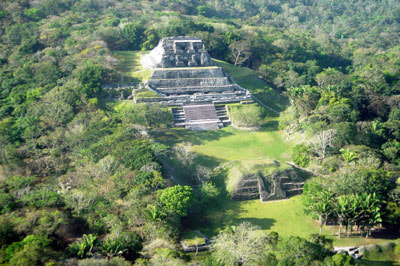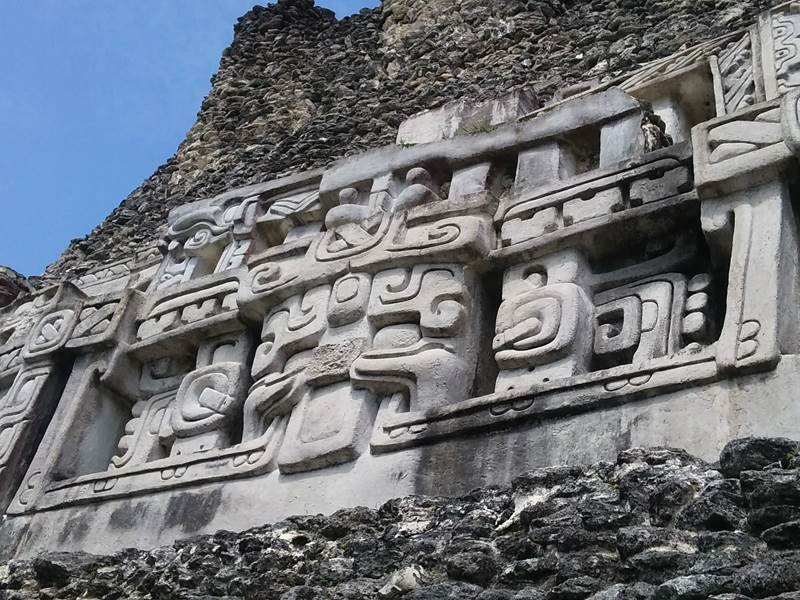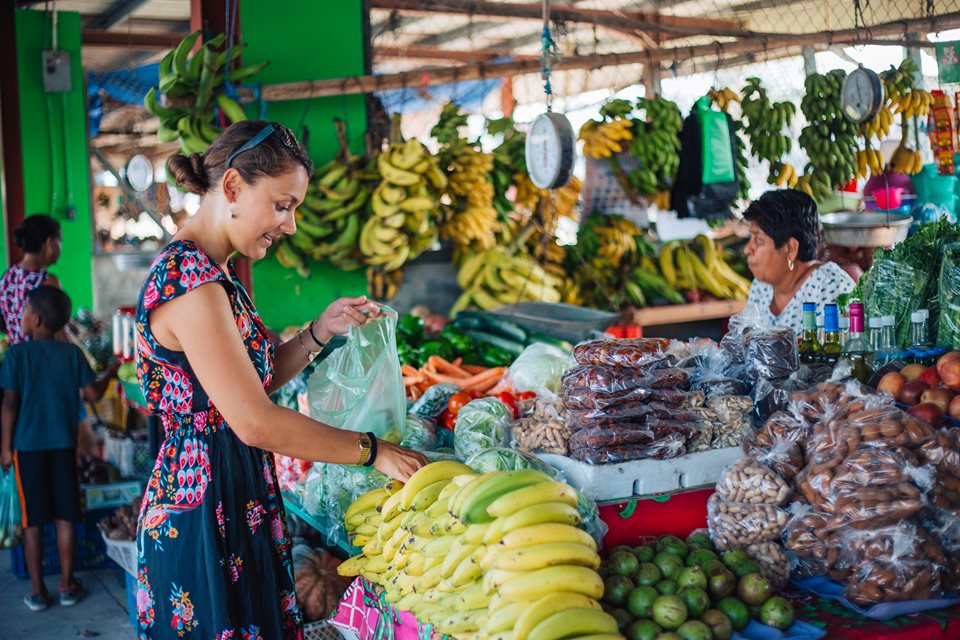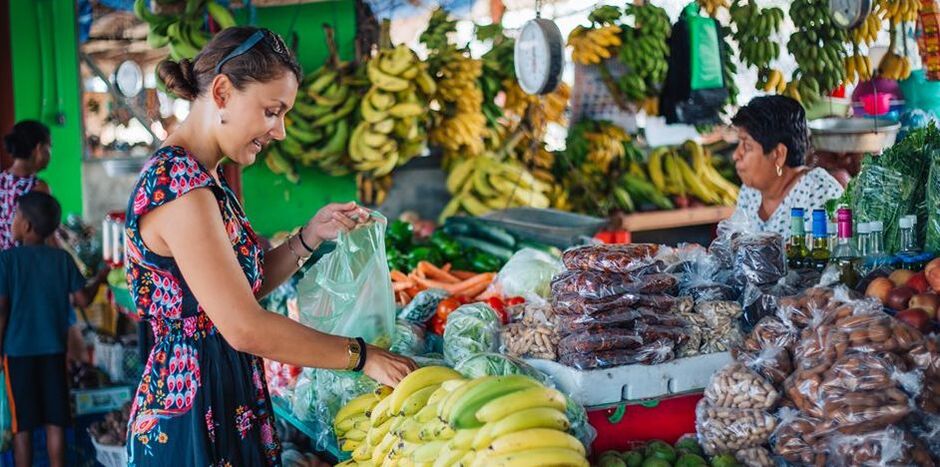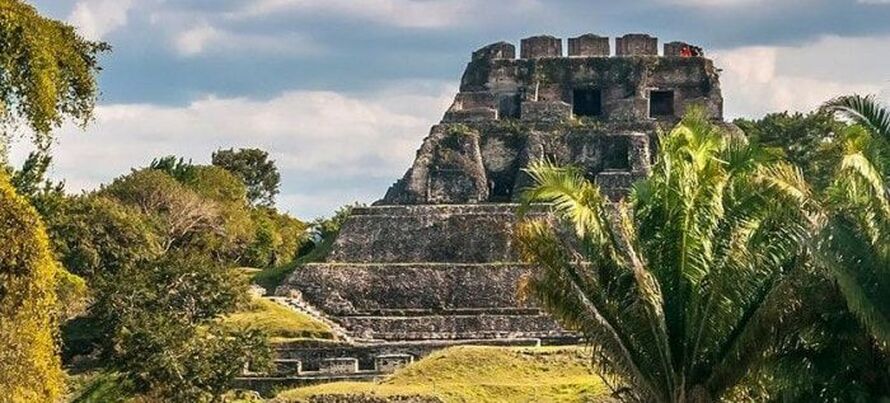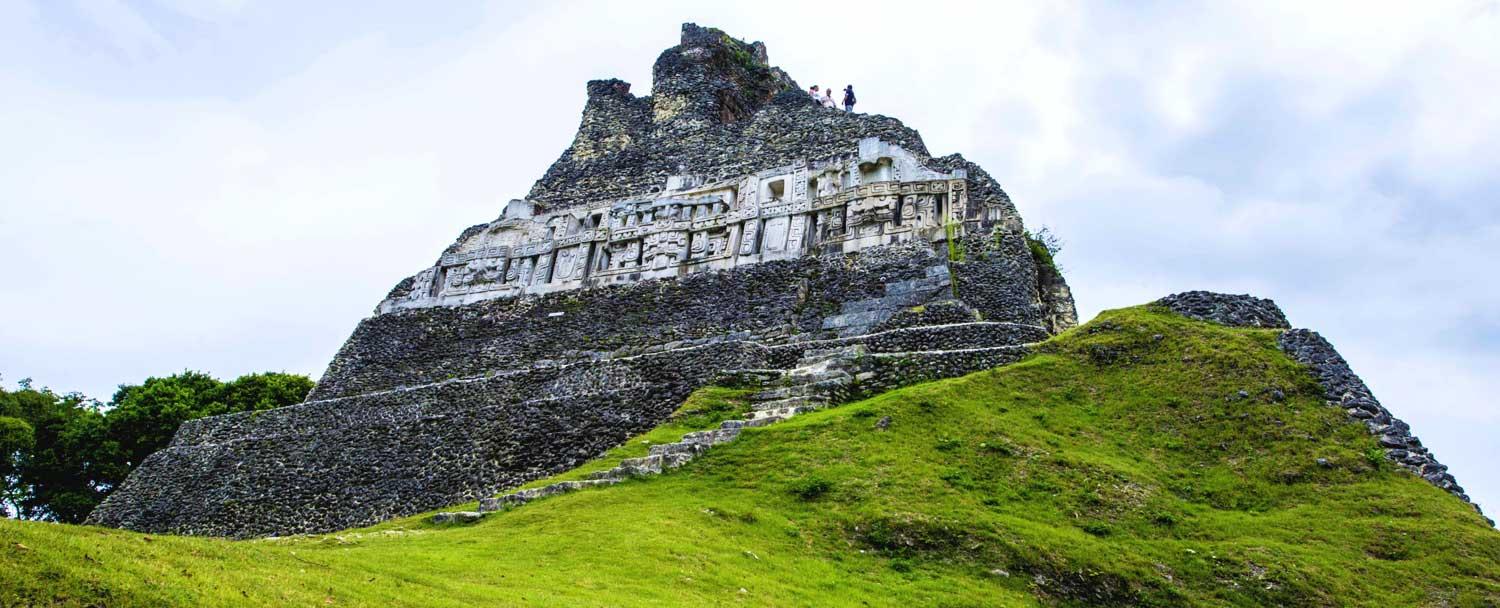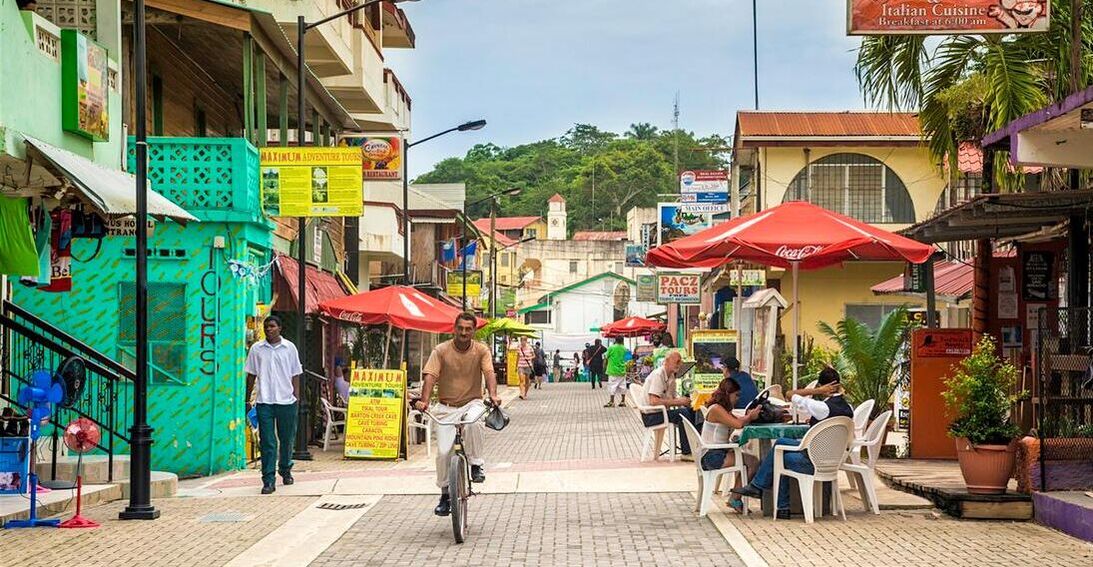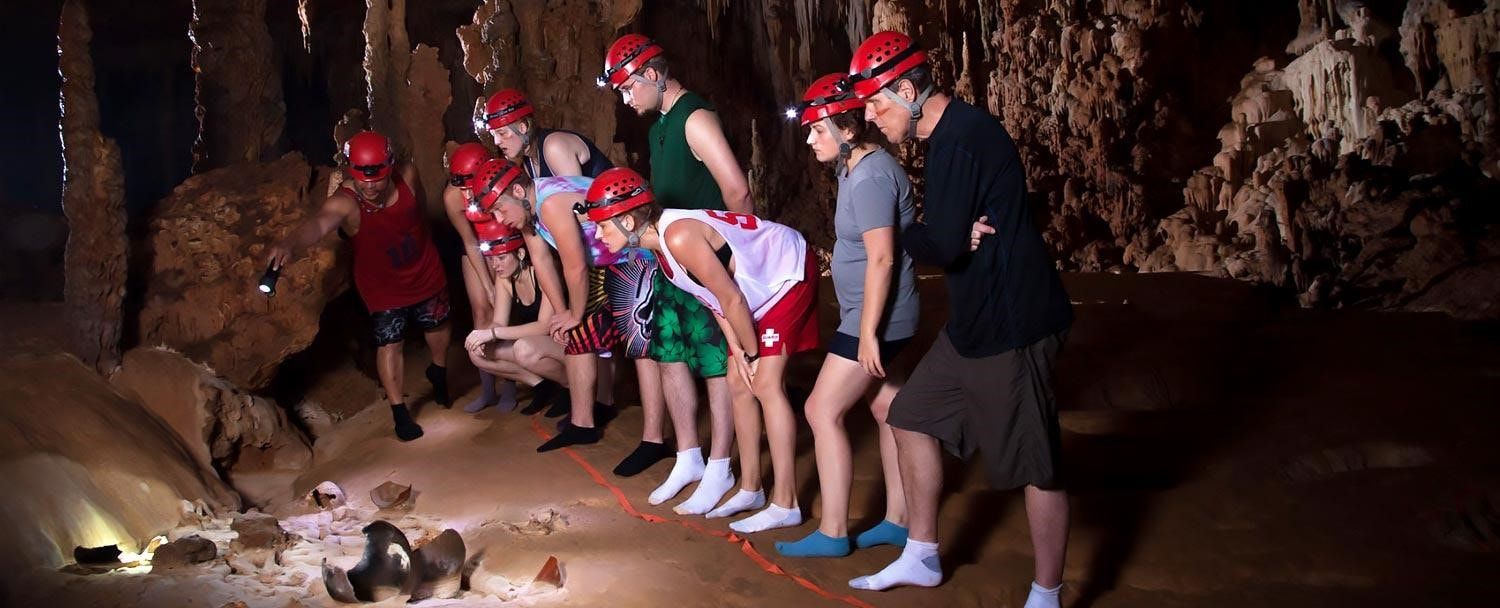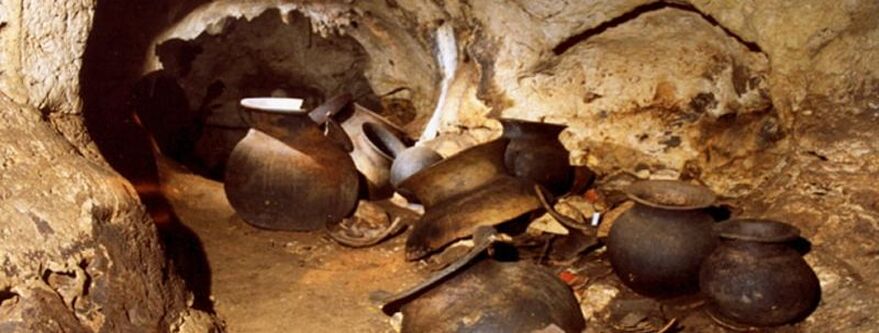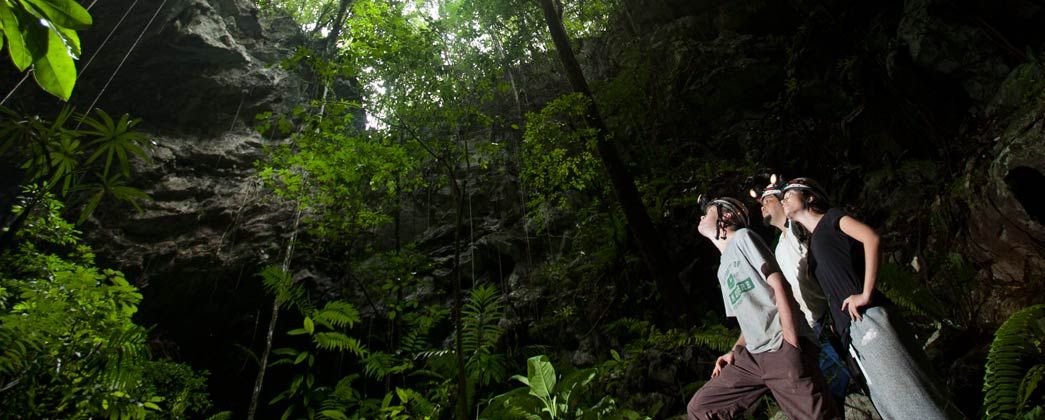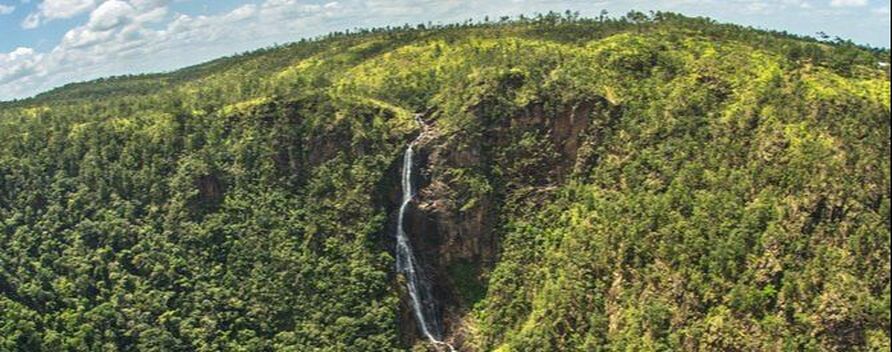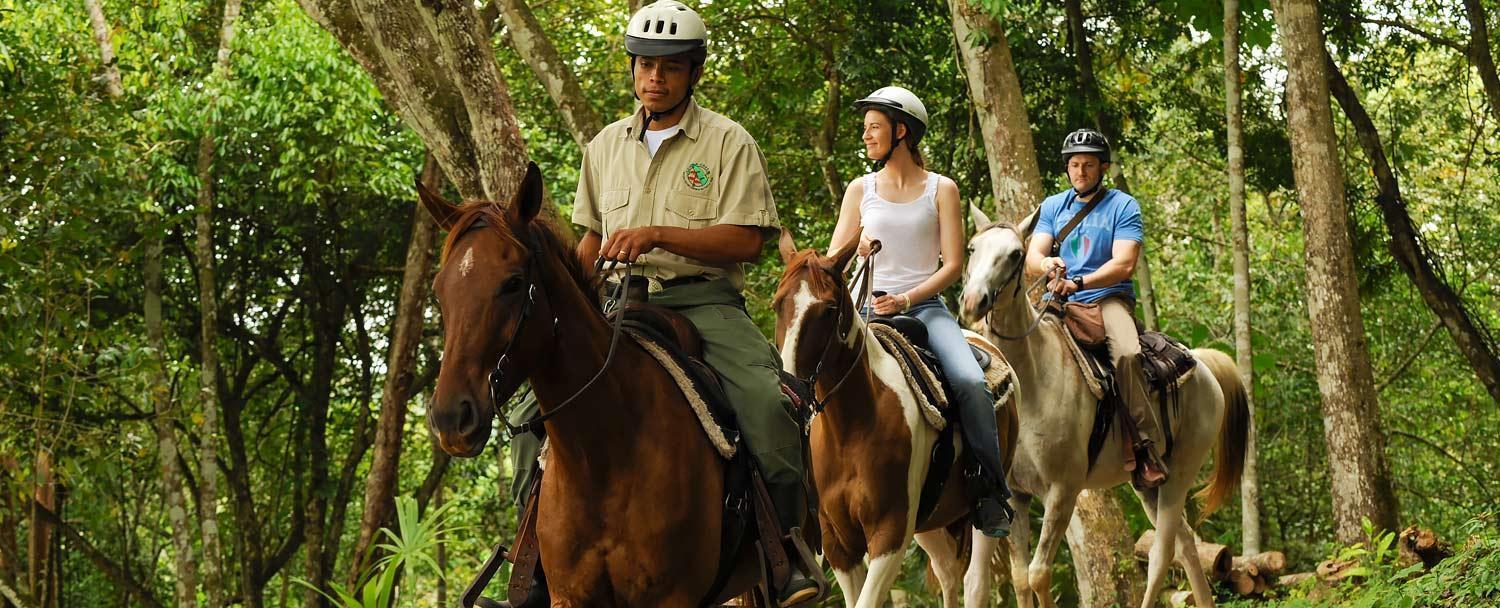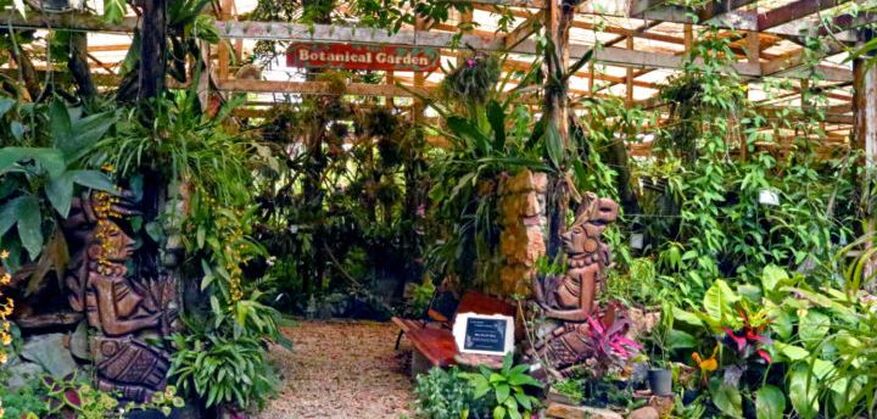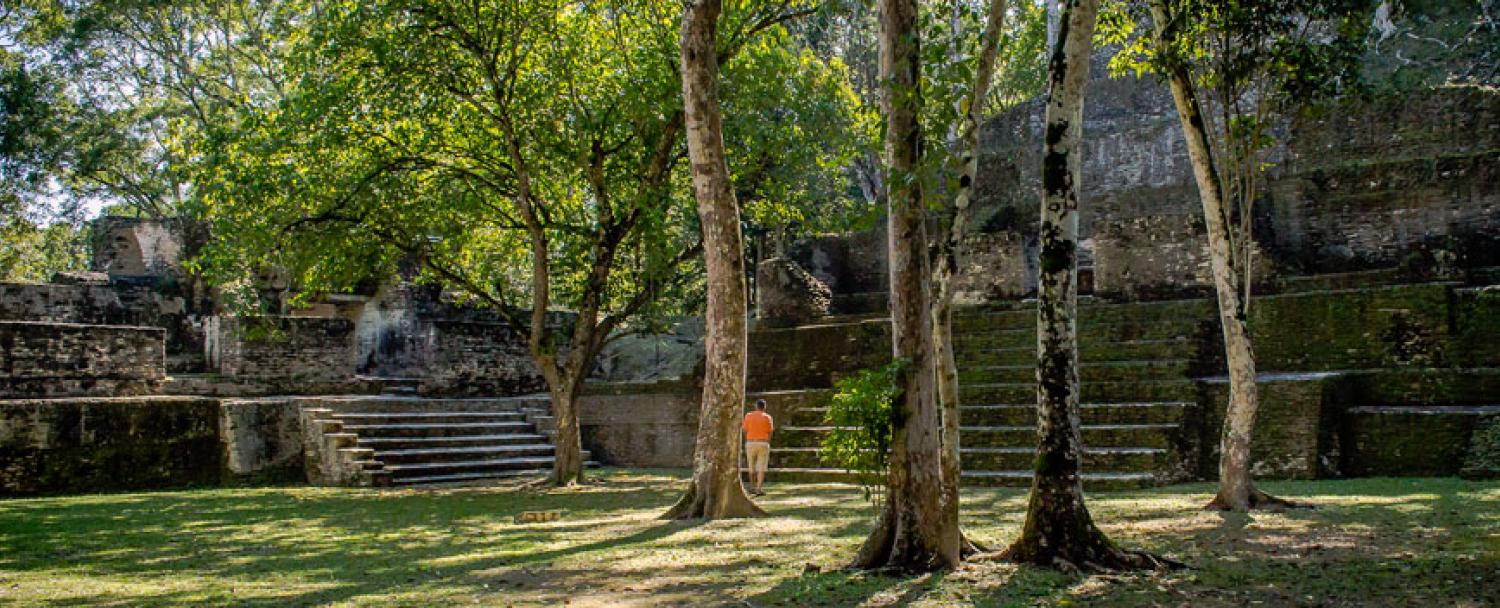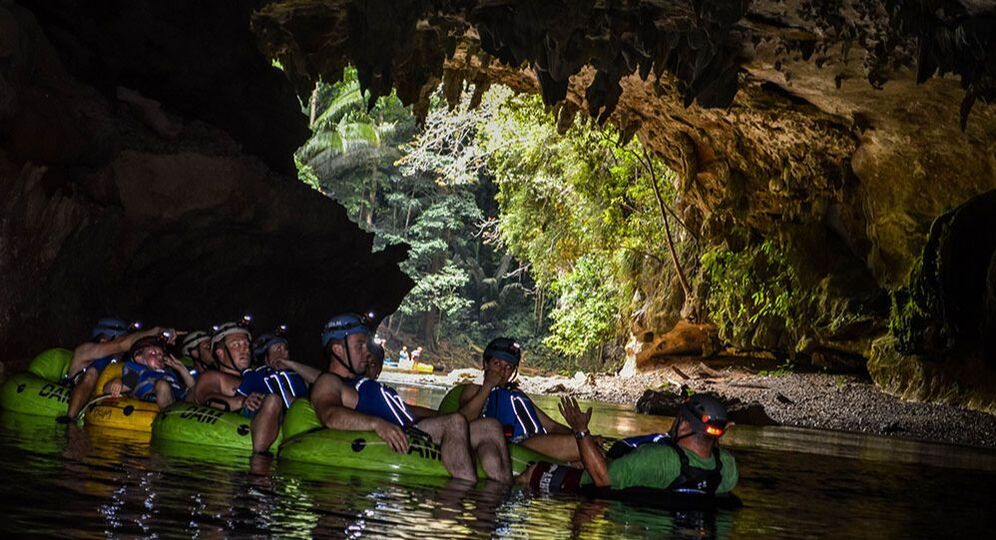CAYO DISTRICT
Why consider vacationing in the Cayo District?
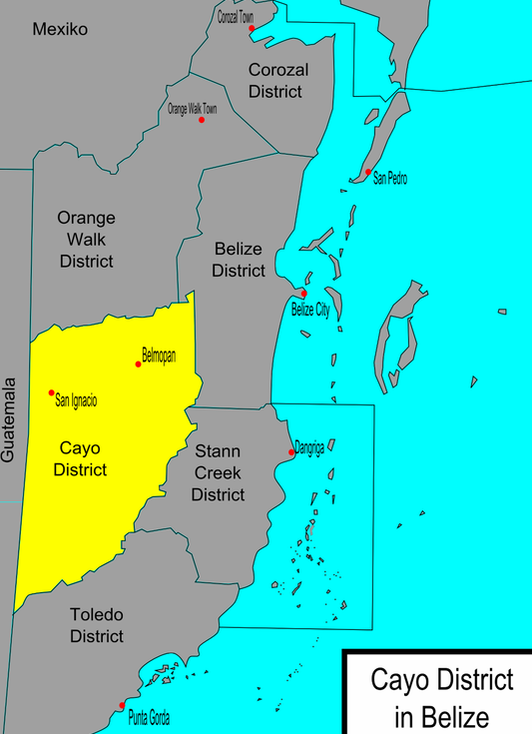
Cayo is smack dab in the middle of the Belizean rainforest, and the center of many ancient Mayan archeological sites. The Cayo District, boasts of some of the best jungle lodges in the country. Here you will find the Caracol & Xunantunich Mayan ruins, the famous ATM and Chechem Ha Caves. All excursions, you don't want to miss!
Cayo District is a district in the west of the nation of Belize. The District capital is the town of San Ignacio Cayo. Also in the Cayo District are the Belizean national capital of Belmopan, the town of Benque Viejo del Carmen, the villages of San Antonio Cayo Valley of Peace, St. Margret's, Roaring Creek, Albaina, and Spanish Lookout. Cayo District also contains the Pre-Columbian Maya ruins of Xunantunich, Cahal Pech, and Caracol.
The Cayo District is primarily an agricultural district, with the chief crops being citrus, (oranges, grapefruit, and tangerine), as well as bananas. There are 2 major highways in the District. The Western Highway, which runs from Belize City to the Guatemalan border. And the Hummingbird Highway which starts in Belmopan and ends at the juncture of the Dangriga Coastal Road and the Southern Highway in the Stann Creek District. In addition to the ruins listed above there are several other tourists attractions including 2 National Parks, Blue Hole (park) and Guancaste. Ecotourism is also an integral part of the region's economy.
Cayo is where to go if you;re looking for inland adventures, pristine waterfalls, exciting wildlife and plenty of natural beauty. The Mountain Pine ridge is one of the highlights as you travel from the jungle into a pine forest hidden in the hills of Cayo. Here you will find the Thousand Foot Falls, Rio on the Caves, Rio Frio Pools, a butterfly farm and beautiful rivers. Cayo is also home to some of the most famous maya sites in Belize, Xunantunich, Cahal Pech and Caracol are all worth a visit. Extreme adventures should check out The Ruta Maya River Challenge in March. Other attractions include the inland Blue Hole, horseback riding, canoeing, underground rivers, hiking, cave tubing, zip lining, mountain biking and birding.
Cayo District is a district in the west of the nation of Belize. The District capital is the town of San Ignacio Cayo. Also in the Cayo District are the Belizean national capital of Belmopan, the town of Benque Viejo del Carmen, the villages of San Antonio Cayo Valley of Peace, St. Margret's, Roaring Creek, Albaina, and Spanish Lookout. Cayo District also contains the Pre-Columbian Maya ruins of Xunantunich, Cahal Pech, and Caracol.
The Cayo District is primarily an agricultural district, with the chief crops being citrus, (oranges, grapefruit, and tangerine), as well as bananas. There are 2 major highways in the District. The Western Highway, which runs from Belize City to the Guatemalan border. And the Hummingbird Highway which starts in Belmopan and ends at the juncture of the Dangriga Coastal Road and the Southern Highway in the Stann Creek District. In addition to the ruins listed above there are several other tourists attractions including 2 National Parks, Blue Hole (park) and Guancaste. Ecotourism is also an integral part of the region's economy.
Cayo is where to go if you;re looking for inland adventures, pristine waterfalls, exciting wildlife and plenty of natural beauty. The Mountain Pine ridge is one of the highlights as you travel from the jungle into a pine forest hidden in the hills of Cayo. Here you will find the Thousand Foot Falls, Rio on the Caves, Rio Frio Pools, a butterfly farm and beautiful rivers. Cayo is also home to some of the most famous maya sites in Belize, Xunantunich, Cahal Pech and Caracol are all worth a visit. Extreme adventures should check out The Ruta Maya River Challenge in March. Other attractions include the inland Blue Hole, horseback riding, canoeing, underground rivers, hiking, cave tubing, zip lining, mountain biking and birding.
THINGS TO DO - Cayo District
|
Top Attractions in Cayo District
|
How to get to San Ignacio/Cayo
Thanks to not just the friendly skies but the crowded skies of Belize that are home to an expansive number of airliners now making nonstop flights between North America and Belize, you’ll have your pick of departure times and rates courtesy of the competition that’s arisen on this route. Your flight to Belize City may only take hours if you depart from the southern U.S., and once you land, getting to Cayo is a breeze. If your airport pickup isn’t sorted by your resort host, flag a taxi and have the driver take you to the bus terminal (about $50 BZD) and then complete your travels via a $10 bus ride to San Ignacio. Want a custom ride? Choose from six transport services happy claim you from the airport and take you directly to Cayo for around $75 BZD (this eliminates the cab ride, by the way). Obtain shuttle recommendations from your lodging host or pick a sentimental favorite: Eva’s, Nine Belize Shuttles or Roam Belize Shuttles and Transfers. They’ve all been around awhile! |
Things To See & Do In the Cayo District
Nobody leaves Cayo without seeing at least one Mayan ruin. The most often-visited in the district are the following three, though if you cross into Guatemala, you can add Tikal to your journal, too.
Actun Tunichil Muknal (ATM) if trekking through jungle and traversing a river before disappearing into a cave housing skeletal remains of long-dead Mayans doesn’t spook you.
Cahal Pech is a small but impressive ruin featuring restored temples and plazas. This site comes with a caveat: The climb to reach Cahal Pech is steep, so make sure you’re in good shape before you lace up your sturdy shoes.
Xunantunich hosts the tallest building in Belize: the spectacular El Castillo pyramid. Gaze down at the Mopan and Macal rivers after climbing 130 feet to the top and prepare yourself for the breathtaking views below.
What to see outside of San Ignacio Town-Visit the Green Hills Butterfly Ranch, a 2,700 square foot enclave filled with butterflies in flight. They’re friendly creatures, so don’t jump if one or more lands on your shoulder or hand. The colors of these winged wonders will astound you. This is no time to forget your camera.
If you prefer living things that stand still rather than hovering over your head, you must see the Belize Botanic Gardens. Wear comfy shoes because this vast swath of nature spans 50-acres of indigenous trees, flowers and greenery. Improving and restoring these gardens is a labor of love for Belize. Visit and you’ll understand why.
Learn about the origins of botanical medicines by visiting Belize’s Medicinal Jungle Trail. Cover 14 acres of plants while guides fascinate you with information about the medicinal properties of plants that may already be used in your meds! Spot “gardeners” along the way: iguanas, anteaters and birds.
What to see by canoe in San Ignacio Town-The Macal River is an aquatic marvel, so if you hire a canoe and explore this area, the four-star show along the banks is guaranteed to amaze and delight. Paddle through waters bounded by jungle vegetation as you spot birds and wildlife. Travel further upstream and you can swim in a wonderland of pools and waterfalls
Okay, so it doesn’t constitute a boat trip, but if you go cave tubing at Jaguar Paw, a sacred underground Mayan enclave that sends you sailing beneath stalactites and past pottery and artifacts that are at least 1,000 years old, you will have to take to the water. Re-start your engines after your tube ride by riding the Jaguar Paw zip line.
What to see in San Ignacio Town town–The Saturday morning open air market in Cayo is a tradition. Farmers throughout the district bring their wares to town that include dairy products, vegetables, jams and fruit. Planning a picnic? Pick up your provisions here.
The San Ignacio & Santa Elena House of Culture is the district’s homage to Belize creativity. Within the small museum, the work of local artists are on display but you can also attend a performance or participate in activities. This little museum even holds classes to make sure Cayo’s creative wellspring never dries up.
Forgive the pun, but we’re going out on a limb here to introduce an attraction that isn’t exactly “in town”: the Green Iguana Exhibit headquartered at the San Ignacio Resort Hotel. If iguanas fascinate you, this 14-acre conserve that’s referred to lovingly as “the only jungle in town” is going to wind up as your favorite memory. While iguanas are the stars of this preserve, nature puts on quite the show thanks to the variety of trees, plants and wildlife here.
Nobody leaves Cayo without seeing at least one Mayan ruin. The most often-visited in the district are the following three, though if you cross into Guatemala, you can add Tikal to your journal, too.
Actun Tunichil Muknal (ATM) if trekking through jungle and traversing a river before disappearing into a cave housing skeletal remains of long-dead Mayans doesn’t spook you.
Cahal Pech is a small but impressive ruin featuring restored temples and plazas. This site comes with a caveat: The climb to reach Cahal Pech is steep, so make sure you’re in good shape before you lace up your sturdy shoes.
Xunantunich hosts the tallest building in Belize: the spectacular El Castillo pyramid. Gaze down at the Mopan and Macal rivers after climbing 130 feet to the top and prepare yourself for the breathtaking views below.
What to see outside of San Ignacio Town-Visit the Green Hills Butterfly Ranch, a 2,700 square foot enclave filled with butterflies in flight. They’re friendly creatures, so don’t jump if one or more lands on your shoulder or hand. The colors of these winged wonders will astound you. This is no time to forget your camera.
If you prefer living things that stand still rather than hovering over your head, you must see the Belize Botanic Gardens. Wear comfy shoes because this vast swath of nature spans 50-acres of indigenous trees, flowers and greenery. Improving and restoring these gardens is a labor of love for Belize. Visit and you’ll understand why.
Learn about the origins of botanical medicines by visiting Belize’s Medicinal Jungle Trail. Cover 14 acres of plants while guides fascinate you with information about the medicinal properties of plants that may already be used in your meds! Spot “gardeners” along the way: iguanas, anteaters and birds.
What to see by canoe in San Ignacio Town-The Macal River is an aquatic marvel, so if you hire a canoe and explore this area, the four-star show along the banks is guaranteed to amaze and delight. Paddle through waters bounded by jungle vegetation as you spot birds and wildlife. Travel further upstream and you can swim in a wonderland of pools and waterfalls
Okay, so it doesn’t constitute a boat trip, but if you go cave tubing at Jaguar Paw, a sacred underground Mayan enclave that sends you sailing beneath stalactites and past pottery and artifacts that are at least 1,000 years old, you will have to take to the water. Re-start your engines after your tube ride by riding the Jaguar Paw zip line.
What to see in San Ignacio Town town–The Saturday morning open air market in Cayo is a tradition. Farmers throughout the district bring their wares to town that include dairy products, vegetables, jams and fruit. Planning a picnic? Pick up your provisions here.
The San Ignacio & Santa Elena House of Culture is the district’s homage to Belize creativity. Within the small museum, the work of local artists are on display but you can also attend a performance or participate in activities. This little museum even holds classes to make sure Cayo’s creative wellspring never dries up.
Forgive the pun, but we’re going out on a limb here to introduce an attraction that isn’t exactly “in town”: the Green Iguana Exhibit headquartered at the San Ignacio Resort Hotel. If iguanas fascinate you, this 14-acre conserve that’s referred to lovingly as “the only jungle in town” is going to wind up as your favorite memory. While iguanas are the stars of this preserve, nature puts on quite the show thanks to the variety of trees, plants and wildlife here.
What To Each & Drink In the Cayo District
A better introduction to this section might be, “Why you should sample everything you can put on your fork!” Even upscale eateries are affordable (between $10 and $12 BZD per person) and if you follow tradition by patronizing street vendors and small eateries, you can expect hardy portions of tasty food that make Cayo the capital of good eating on a shoestring. Culinary diversity is on display here, so sample dishes representing many ethnic cooking traditions. It only costs about $3 BZD for a beer and at Cayo bars; find out when happy hour takes place and order two beverages for the price of one. By the way, the Belize happy hour is more likely a happy three hours. Where to dine? Try Ko-Ox Han-Nah for awesome bites and fabulous service, Belize fast food as you’ve never tasted it at Mincho’s, Erva’s rice and beans with red snapper will send your spirit soaring to food heaven and if you’re a stickler for organic produce, dishes cooked at the Cahal Pech Village Resort Restaurant are sourced at San Ignacio’s farmers markets. Get your fine self to Mr. Greedy’s if you can’t survive without pizza.
Where to Stay in the Cayo District (Where To Stay)
Where to stay on a budget? Lest you think that only luxury resorts await you and your wallet in San Ignacio, you’re in for a surprise. Not only will you have your pick of four-star luxury hotels that pamper guests like crazy, but there are perfectly nice budget hotels ready to cater to your needs if you’d rather spend your cash on experiences rather than snoozing! No matter what you can afford, you’ll be accommodated. Book a nice double room at a hotel for between $100 and $120 BZD per night. Package rates for longer stays save money and if they’re not booked, you might even prefer one of Cayo’s bed and breakfasts. Cutting corners? We hear you: check into a hostel for between $25 and $30 BZD per person, per night. As you can see, San Ignacio is delighted to host travelers from all walks of life, so whether you require a palatial mansion, a single hotel room, a tropical hideaway with Mother Nature as your roommate or modest digs, you’ll find plenty of choices here.
A better introduction to this section might be, “Why you should sample everything you can put on your fork!” Even upscale eateries are affordable (between $10 and $12 BZD per person) and if you follow tradition by patronizing street vendors and small eateries, you can expect hardy portions of tasty food that make Cayo the capital of good eating on a shoestring. Culinary diversity is on display here, so sample dishes representing many ethnic cooking traditions. It only costs about $3 BZD for a beer and at Cayo bars; find out when happy hour takes place and order two beverages for the price of one. By the way, the Belize happy hour is more likely a happy three hours. Where to dine? Try Ko-Ox Han-Nah for awesome bites and fabulous service, Belize fast food as you’ve never tasted it at Mincho’s, Erva’s rice and beans with red snapper will send your spirit soaring to food heaven and if you’re a stickler for organic produce, dishes cooked at the Cahal Pech Village Resort Restaurant are sourced at San Ignacio’s farmers markets. Get your fine self to Mr. Greedy’s if you can’t survive without pizza.
Where to Stay in the Cayo District (Where To Stay)
Where to stay on a budget? Lest you think that only luxury resorts await you and your wallet in San Ignacio, you’re in for a surprise. Not only will you have your pick of four-star luxury hotels that pamper guests like crazy, but there are perfectly nice budget hotels ready to cater to your needs if you’d rather spend your cash on experiences rather than snoozing! No matter what you can afford, you’ll be accommodated. Book a nice double room at a hotel for between $100 and $120 BZD per night. Package rates for longer stays save money and if they’re not booked, you might even prefer one of Cayo’s bed and breakfasts. Cutting corners? We hear you: check into a hostel for between $25 and $30 BZD per person, per night. As you can see, San Ignacio is delighted to host travelers from all walks of life, so whether you require a palatial mansion, a single hotel room, a tropical hideaway with Mother Nature as your roommate or modest digs, you’ll find plenty of choices here.
XUNANTUNICH MAYAN TEMPLE
Xunantunich Maya Temple Site
It's definitely worth crossing the river to spend a long morning or a lazy afternoon in this ancient Maya city.The name of this ancient Mayan ruin is a tongue twister, but to indigenous peoples who made this sacred site their home for millennia, Xunantunich was a safe, secure hilltop area with plenty of vantage points, just in case a neighboring army of usurpers or explorers from abroad sought to claim this stronghold. Though this site was settled–according to social scientists–around the 1st Century BC, builders didn’t develop the area until the 7th Century AD. The mystery surrounding the collapse of this Mayan population around 850 AD hasn’t been solved, but not a soul was left here by 1000 AD.
Though the excavated portion of Xunantunich occupies about 300 square meters of land, there is more to be unearthed. What remains behind tells of a quintessential Classic Period ceremonial center, but what separates this from other ruins is the domination of El Castillo, the tallest structure (sometimes called a pyramid) in Belize. It’s thought that this huge structure was the last ruling family’s ancestral shrine. The compound is divided into plazas for easy identification, but if you need more guidance to interpret features, find detailed information about the ruin at the visitor’s center.
It's definitely worth crossing the river to spend a long morning or a lazy afternoon in this ancient Maya city.The name of this ancient Mayan ruin is a tongue twister, but to indigenous peoples who made this sacred site their home for millennia, Xunantunich was a safe, secure hilltop area with plenty of vantage points, just in case a neighboring army of usurpers or explorers from abroad sought to claim this stronghold. Though this site was settled–according to social scientists–around the 1st Century BC, builders didn’t develop the area until the 7th Century AD. The mystery surrounding the collapse of this Mayan population around 850 AD hasn’t been solved, but not a soul was left here by 1000 AD.
Though the excavated portion of Xunantunich occupies about 300 square meters of land, there is more to be unearthed. What remains behind tells of a quintessential Classic Period ceremonial center, but what separates this from other ruins is the domination of El Castillo, the tallest structure (sometimes called a pyramid) in Belize. It’s thought that this huge structure was the last ruling family’s ancestral shrine. The compound is divided into plazas for easy identification, but if you need more guidance to interpret features, find detailed information about the ruin at the visitor’s center.
SAN IGNACIO TOWN
San Ignacio Town
Everything You Need to Know About Visiting San Ignacio - No visitor departs Belize without leaving a piece of their heart behind, and this is particularly true of travelers who have found their own version of paradise in San Ignacio, a glorious, friendly destination that’s so close to Guatemala, you can get a second stamp on your passport if you insist on leaving Belize. But, why bother? There’s so much to see, do, taste and learn in the district known simply as “Cayo,” your time and energy are much better spent in this intriguing area of Belize. Need to plan your trip so you don’t waste a minute of time? Start with our suggestions and you’ll be ready to fly.
Getting around San Ignacio Town - Visitors like to say that San Ignacio has a wonderfully spirited vibe that reminds them of a rough and tumble jungle, but in fact, it’s got just enough balance in terms of old and new to offer character you won’t find elsewhere in Belize. Stay in town and walk to plenty of places on your own, or book excursions to see the sites by checking in with your lodging concierge or by patronizing any of the licensed tour guide services in and around town. If you’re the independent sort and prefer being on your own, you can work through bus routes to take you anywhere you wish to go. Since bus ticket rates are calculated by destination, do check at the depot to find out how much the route you require costs before you buy your ticket(s). Don’t be shocked to see hitchhikers thumbing rides along roadsides as you travel the district and beyond. It’s common practice here. Of course, if you rented a car in Belize City after your plane landed, your transportation worries are solved.
Everything You Need to Know About Visiting San Ignacio - No visitor departs Belize without leaving a piece of their heart behind, and this is particularly true of travelers who have found their own version of paradise in San Ignacio, a glorious, friendly destination that’s so close to Guatemala, you can get a second stamp on your passport if you insist on leaving Belize. But, why bother? There’s so much to see, do, taste and learn in the district known simply as “Cayo,” your time and energy are much better spent in this intriguing area of Belize. Need to plan your trip so you don’t waste a minute of time? Start with our suggestions and you’ll be ready to fly.
Getting around San Ignacio Town - Visitors like to say that San Ignacio has a wonderfully spirited vibe that reminds them of a rough and tumble jungle, but in fact, it’s got just enough balance in terms of old and new to offer character you won’t find elsewhere in Belize. Stay in town and walk to plenty of places on your own, or book excursions to see the sites by checking in with your lodging concierge or by patronizing any of the licensed tour guide services in and around town. If you’re the independent sort and prefer being on your own, you can work through bus routes to take you anywhere you wish to go. Since bus ticket rates are calculated by destination, do check at the depot to find out how much the route you require costs before you buy your ticket(s). Don’t be shocked to see hitchhikers thumbing rides along roadsides as you travel the district and beyond. It’s common practice here. Of course, if you rented a car in Belize City after your plane landed, your transportation worries are solved.
ATM CAVE (Actun Tunikil Muknul)
ATM Cave (Actun Tunikil Muknul)
Spelunk it in any of Cayo's fascinating caves, especially this one. The "Cave of the Crystal Maiden" is the wettest, dirtiest, most adventurous undergroun trip available. More caving action is available at Barton Creek, Rio Frio, and Chechem Ha Caves.
Even to the untrained eye, a peek inside a cave that was once home to an ancient civilization holds plenty of fascination. Rock walls. Strange ceiling and floor projectiles formed as water and minerals dripped and solidified for centuries. Spiders, bats and even fish coexist nicely, yet for the purist, no cavern is created equal—especially if that cave happens to be Belize’s Actun Tunichil Muknal Cave, otherwise known as the ATM Cave. This stronghold of ancient Mayan secrets and rituals will keep you spellbound from the moment you arrive.Here are six things you should know before you go there to make your visit even more magical.
Once your eyes are accustomed to varying shades of black to grey that fill the ATM’s interior and you turn on your helmet light, you’ll spot the interiors of chamber after chamber until you arrive at The Cathedral. The cave’s most dramatic finds are here, including calcified skeletal remains of “The Crystal Maiden” whose bones sparkle like jewels due to centuries of mineral buildup. She’s not alone. Scan shelves and nooks to discover bones, relics, pottery and other ancient treasures in the dark silence of this inner chamber.
Spelunk it in any of Cayo's fascinating caves, especially this one. The "Cave of the Crystal Maiden" is the wettest, dirtiest, most adventurous undergroun trip available. More caving action is available at Barton Creek, Rio Frio, and Chechem Ha Caves.
Even to the untrained eye, a peek inside a cave that was once home to an ancient civilization holds plenty of fascination. Rock walls. Strange ceiling and floor projectiles formed as water and minerals dripped and solidified for centuries. Spiders, bats and even fish coexist nicely, yet for the purist, no cavern is created equal—especially if that cave happens to be Belize’s Actun Tunichil Muknal Cave, otherwise known as the ATM Cave. This stronghold of ancient Mayan secrets and rituals will keep you spellbound from the moment you arrive.Here are six things you should know before you go there to make your visit even more magical.
Once your eyes are accustomed to varying shades of black to grey that fill the ATM’s interior and you turn on your helmet light, you’ll spot the interiors of chamber after chamber until you arrive at The Cathedral. The cave’s most dramatic finds are here, including calcified skeletal remains of “The Crystal Maiden” whose bones sparkle like jewels due to centuries of mineral buildup. She’s not alone. Scan shelves and nooks to discover bones, relics, pottery and other ancient treasures in the dark silence of this inner chamber.
CHECHEM HA CAVE & VACA PLATEAU
Chechem Ha Cave & Vaca Plateau
The only thing more inspiring than the pottery and mystery found inside Chechem Ha Cave is the waterfall by the same name and the views across the Macal River from this incredible perch on the plateau.
One visitor called Che Chem Ha Cave the antithesis of Barton Creek where one ambles into a cavern that’s free of physical challenges! On the other hand, a visit to Che Chem Ha isn’t a walk in the park. It’s a first-class adventure that includes a strenuous hike to the cave’s mouth, exploration of a wonderland of artifacts you won’t see elsewhere and opportunities to claim bragging rights after returning home with your exciting stories.
Che Chem Ha’s stalactites and stalagmites aren’t the most dramatic in Belize, but you won’t care once you begin to explore narrow passages filled with the largest stash of ancient vessels, plates, pots and lids found in Belize. From shards to large vessels, some retain original, artistic decorations. Walk further to discover ladders propped against walls that lead to shelves and chambers holding more Mayan relics, some of which still include ancient seeds and decomposed maize used to conduct secret ceremonies.
The only thing more inspiring than the pottery and mystery found inside Chechem Ha Cave is the waterfall by the same name and the views across the Macal River from this incredible perch on the plateau.
One visitor called Che Chem Ha Cave the antithesis of Barton Creek where one ambles into a cavern that’s free of physical challenges! On the other hand, a visit to Che Chem Ha isn’t a walk in the park. It’s a first-class adventure that includes a strenuous hike to the cave’s mouth, exploration of a wonderland of artifacts you won’t see elsewhere and opportunities to claim bragging rights after returning home with your exciting stories.
Che Chem Ha’s stalactites and stalagmites aren’t the most dramatic in Belize, but you won’t care once you begin to explore narrow passages filled with the largest stash of ancient vessels, plates, pots and lids found in Belize. From shards to large vessels, some retain original, artistic decorations. Walk further to discover ladders propped against walls that lead to shelves and chambers holding more Mayan relics, some of which still include ancient seeds and decomposed maize used to conduct secret ceremonies.
BLACK HOLE DROP (Actun Loch Tunich)
Black Hole Drop (Actun Loch Tunich)
Although the name of the Black Hole Drop implies dropping into a bottomless pit, the Black Hole Drop is actually a unique climbing adventure where participants get lowered down through the floor of a cave that sits high above the nearby jungle canopy. As participants rappel further downward, they will pass through the canopy layer until they arrive in a deep hole that looks inky black, hence the name.
The tour begins by a hike through the jungle up to a cave named Actun Loch Tunich. From there, participants are carefully connected to a safety harness. The adventure begins when participants lower themselves over a ledge on the cave floor seemingly to descend into complete blackness.
Some 200 feet below the floor of the cave, participants will reach the upper level of the nearby jungle canopy. Facing their fears of heights, participants will continue to rappel downward through tree branches until they touch ground at the bottom of a cavern. As the cavern looks completely black from above, this is where the “black drop” name comes from. The total descent is approximately 500 feet (152 meters), requiring participants to master their fear of heights to enjoy this unique adventure experience.
Although the name of the Black Hole Drop implies dropping into a bottomless pit, the Black Hole Drop is actually a unique climbing adventure where participants get lowered down through the floor of a cave that sits high above the nearby jungle canopy. As participants rappel further downward, they will pass through the canopy layer until they arrive in a deep hole that looks inky black, hence the name.
The tour begins by a hike through the jungle up to a cave named Actun Loch Tunich. From there, participants are carefully connected to a safety harness. The adventure begins when participants lower themselves over a ledge on the cave floor seemingly to descend into complete blackness.
Some 200 feet below the floor of the cave, participants will reach the upper level of the nearby jungle canopy. Facing their fears of heights, participants will continue to rappel downward through tree branches until they touch ground at the bottom of a cavern. As the cavern looks completely black from above, this is where the “black drop” name comes from. The total descent is approximately 500 feet (152 meters), requiring participants to master their fear of heights to enjoy this unique adventure experience.
THOUSAND FOOT FALLS
Thousand Foot Falls
The trip to Central America's highest waterfall is well worth enduring the rough access road. You can't swim here, but the vista of the falls from the lookout on the canyon's edge is stunning. Located deep within a nature reserve in western Belize, Thousand Foot Falls is the highest waterfall in all of Central America. A swift river descends over a granite cliff to descend more than 1,600 feet into a thickly forested natural wonderland.
As you wend your way through the verdant hillsides of the Mountain Pine Ridge Forest Reserve, you’ll come across a special viewing area equipped with a public restroom and some benches. From there, you can see the majesty of the largest waterfall in all of Central America. Although its waters descend more than 1,600 feet into a thickly forested gorge, the waterfall is known in Belize as Thousand Foot Falls. Committed hikers can also descend their way to the disgorgement pool at the bottom of the waterfall to enjoy a refreshing dip in the delightfully cool waters.
The trip to Central America's highest waterfall is well worth enduring the rough access road. You can't swim here, but the vista of the falls from the lookout on the canyon's edge is stunning. Located deep within a nature reserve in western Belize, Thousand Foot Falls is the highest waterfall in all of Central America. A swift river descends over a granite cliff to descend more than 1,600 feet into a thickly forested natural wonderland.
As you wend your way through the verdant hillsides of the Mountain Pine Ridge Forest Reserve, you’ll come across a special viewing area equipped with a public restroom and some benches. From there, you can see the majesty of the largest waterfall in all of Central America. Although its waters descend more than 1,600 feet into a thickly forested gorge, the waterfall is known in Belize as Thousand Foot Falls. Committed hikers can also descend their way to the disgorgement pool at the bottom of the waterfall to enjoy a refreshing dip in the delightfully cool waters.
HORSEBACK RIDING
Horseback Riding
One of the best ways to explore the natural beauty of Belize is on horseback. Far from the bustle of roadways and noisy towns, small trails wandering through pine forests, jungles, and savannahs give horseback riders a way to get up close and personal with the wildlife and flora that make Belize one of the most biodiverse countries on the planet.
San Ignacio, the eco-tourism capital of Belize, is one of the most popular places to begin an exploration of the country on horseback. The region around San Ignacio is a delightful mix of verdant, rolling hills and pristine jungle interspersed with rivers, ancient marvels like Maya ruins, and majestic waterfalls. Whether it’s the quiet neigh of your horse or the contentment that comes with using a completely “green” and sustainable form of transportation, few experiences can compare to exploring Belize on horseback.
One of the best ways to explore the natural beauty of Belize is on horseback. Far from the bustle of roadways and noisy towns, small trails wandering through pine forests, jungles, and savannahs give horseback riders a way to get up close and personal with the wildlife and flora that make Belize one of the most biodiverse countries on the planet.
San Ignacio, the eco-tourism capital of Belize, is one of the most popular places to begin an exploration of the country on horseback. The region around San Ignacio is a delightful mix of verdant, rolling hills and pristine jungle interspersed with rivers, ancient marvels like Maya ruins, and majestic waterfalls. Whether it’s the quiet neigh of your horse or the contentment that comes with using a completely “green” and sustainable form of transportation, few experiences can compare to exploring Belize on horseback.
CAVE BRANCH BOTANICAL GARDENS
Cave Branch Botanic Gardens
Founded in 2008, the Caves Branch Botanical Gardens is the largest facility of its kind in Belize. The Botanical Gardens was founded in order to both help protect and conserve the biodiversity of Belize’s ecosystem as well as provide an educational experience for visitors and locals alike to learn more about the incredible beauty and variety of nature in Belize. Since its founding, the Caves Branch Botanical Gardens has become an important reservoir of Belize’s fauna as well as a source for scientific study of indigenous plants in the country.
The national flower of Belize is the black orchid, and the Caves Branch Botanical Gardens is home to more orchid species than anywhere else in the country. The Botanical Gardens is also home to an ever-increasing collection of other epiphytes and bromeliads (known as “air plants”). The Caves Branch Botanical Gardens has also teamed up with the Marie Selby Botanical Gardens in Florida in order to provide an in-depth scientific study and cataloging of epiphyte plants in Belize. Information gathered from the Botanical Gardens has proven highly useful towards successfully protecting the country’s rich natural heritage.
Founded in 2008, the Caves Branch Botanical Gardens is the largest facility of its kind in Belize. The Botanical Gardens was founded in order to both help protect and conserve the biodiversity of Belize’s ecosystem as well as provide an educational experience for visitors and locals alike to learn more about the incredible beauty and variety of nature in Belize. Since its founding, the Caves Branch Botanical Gardens has become an important reservoir of Belize’s fauna as well as a source for scientific study of indigenous plants in the country.
The national flower of Belize is the black orchid, and the Caves Branch Botanical Gardens is home to more orchid species than anywhere else in the country. The Botanical Gardens is also home to an ever-increasing collection of other epiphytes and bromeliads (known as “air plants”). The Caves Branch Botanical Gardens has also teamed up with the Marie Selby Botanical Gardens in Florida in order to provide an in-depth scientific study and cataloging of epiphyte plants in Belize. Information gathered from the Botanical Gardens has proven highly useful towards successfully protecting the country’s rich natural heritage.
CAHAL PECH MAYAN TEMPLE
Cahal Pech Maya Temple Site
The site is unique for both its archeological intrigue and its location within the city limits of San Ignacio, and the walk up the hill is well worth it. The contrast between yesterday and today is remarkable: One can literally stroll between lively, modern San Ignacio Town to an ancient Mayan historic site by walking a mile to the Cahal Pech Mayan ruins. For archaeology buffs, being this close to an active site is an exciting prospect, but your local accommodations won’t be anything like the lodgings archaeologists contend with when they’re at work! Keep reading so you can fully appreciate everything you see once you arrive.
As the oldest-known Maya site in the Belize River Valley, this ruin was built between 1500 and 1000 BC. It’s a spectacular example of Pre-classic period architecture, some of which has survived thousands of years. The name Cahal Pech translates as “Place of Ticks,” referring to tick-infested pastures on which area farmers grazed cattle over time. Archaeologists believe this community was once 10 square miles in size, but the concentration of structures open to visitors is around two miles, so it’s an easy place to navigate. There’s much to see here: 34 structures include a mix of workplaces, homes, temples, palaces, ball courts and stelae, one of which is the oldest in the region.
The site is unique for both its archeological intrigue and its location within the city limits of San Ignacio, and the walk up the hill is well worth it. The contrast between yesterday and today is remarkable: One can literally stroll between lively, modern San Ignacio Town to an ancient Mayan historic site by walking a mile to the Cahal Pech Mayan ruins. For archaeology buffs, being this close to an active site is an exciting prospect, but your local accommodations won’t be anything like the lodgings archaeologists contend with when they’re at work! Keep reading so you can fully appreciate everything you see once you arrive.
As the oldest-known Maya site in the Belize River Valley, this ruin was built between 1500 and 1000 BC. It’s a spectacular example of Pre-classic period architecture, some of which has survived thousands of years. The name Cahal Pech translates as “Place of Ticks,” referring to tick-infested pastures on which area farmers grazed cattle over time. Archaeologists believe this community was once 10 square miles in size, but the concentration of structures open to visitors is around two miles, so it’s an easy place to navigate. There’s much to see here: 34 structures include a mix of workplaces, homes, temples, palaces, ball courts and stelae, one of which is the oldest in the region.
CAVE TUBING (Nohoch Che'en Cave)
Cave Tubing - Nohoch Che'en Cave Branch Reserve
Imagine settling into an oversized rubber inner tube and floating down a river without a care in the world–until you disappear into caves where strange and exotic Mayan rituals were held thousands of years ago. Sound like fun? It should. Tubing is one of Belize’s main attractions and if you specify Nohoch Che’en Caves, you can pick and choose from five different caves, though adventurous souls insist on doing them all! Mother Nature has no dress code here—but be forewarned: you’re likely to get wet.Just about every travel writer experiencing Caves Branch River tubing comes to the conclusion that this destination reminds them of sailing in and out of big hunks of Swiss cheese. One minute the sun is shining upon your head, and in the next, you’ve got jungle canopy shading your sail. But the fun kicks in once you slip into a surreal world of pitch black caves once explored and used by Mayans for rituals and secret ceremonies. Fun for all ages, there’s nothing quite like tubing.
Imagine settling into an oversized rubber inner tube and floating down a river without a care in the world–until you disappear into caves where strange and exotic Mayan rituals were held thousands of years ago. Sound like fun? It should. Tubing is one of Belize’s main attractions and if you specify Nohoch Che’en Caves, you can pick and choose from five different caves, though adventurous souls insist on doing them all! Mother Nature has no dress code here—but be forewarned: you’re likely to get wet.Just about every travel writer experiencing Caves Branch River tubing comes to the conclusion that this destination reminds them of sailing in and out of big hunks of Swiss cheese. One minute the sun is shining upon your head, and in the next, you’ve got jungle canopy shading your sail. But the fun kicks in once you slip into a surreal world of pitch black caves once explored and used by Mayans for rituals and secret ceremonies. Fun for all ages, there’s nothing quite like tubing.
CARACOL MAYAN TEMPLE
Caracol Maya Temple
One of the more difficult major ruins to access in Belize (you'll endure a bumpy, multihour ride along the Moutain Pine Ridge), Caracol is rife with discovery, beauty and long, peaceful views of the wild countryside from atop its newly excavated temples.
Mayans settling Caracol in several waves bestowed two names upon the community: “Three Water Hill” and then “Three Hills Lord,” though its current name wasn’t chosen by Mayan settlers, but by Belize’s Archaeological Commissioner A. H. Anderson in 1938. The largest Mayan site in Belize, Caracol sprawls across 75 square miles, an area greater than Belize City. Of course, that much room was necessary to house a huge population that, at one time, boasted almost 200,000 residents! Learn more about this fascinating epicenter when you visit.
Tour the central core of three plaza grounds bounded by two ball courts, an acropolis, buildings, temples, palaces and sacred sites that include altars and places for ceremonial worship. Perhaps the most often written about attraction at Caracol is the Sky Palace (Caana), the tallest man-made structure in Belize. It towers above the settlement at a height of 136-feet, but for those eager to get a complete picture of this ancient world, the stele, tombs, hieroglyphic inscriptions and intricate architectural details will fill in the voids.
One of the more difficult major ruins to access in Belize (you'll endure a bumpy, multihour ride along the Moutain Pine Ridge), Caracol is rife with discovery, beauty and long, peaceful views of the wild countryside from atop its newly excavated temples.
Mayans settling Caracol in several waves bestowed two names upon the community: “Three Water Hill” and then “Three Hills Lord,” though its current name wasn’t chosen by Mayan settlers, but by Belize’s Archaeological Commissioner A. H. Anderson in 1938. The largest Mayan site in Belize, Caracol sprawls across 75 square miles, an area greater than Belize City. Of course, that much room was necessary to house a huge population that, at one time, boasted almost 200,000 residents! Learn more about this fascinating epicenter when you visit.
Tour the central core of three plaza grounds bounded by two ball courts, an acropolis, buildings, temples, palaces and sacred sites that include altars and places for ceremonial worship. Perhaps the most often written about attraction at Caracol is the Sky Palace (Caana), the tallest man-made structure in Belize. It towers above the settlement at a height of 136-feet, but for those eager to get a complete picture of this ancient world, the stele, tombs, hieroglyphic inscriptions and intricate architectural details will fill in the voids.
